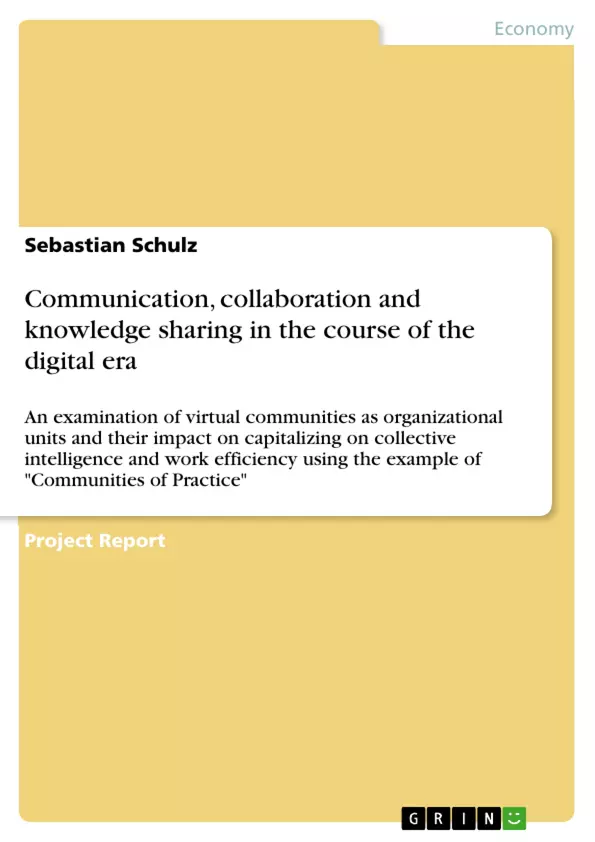Abstract
This paper explores the practicable establishment of local Communities of Practice (CoP) on a virtual level to foster the augmentation of knowledge, sharing of practice and employee development. Communities of Practice have been identified as important sites of learning through creating and sharing knowledge within its social structures. The thesis examines how learning develops in this context and constitutes the basic theoretical attainment that is aligned to CoP. Furthermore, the paper reviews how technology can be introduced to reinforce communication and collaboration within the community. In order to build an understanding of how CoP create organizational value, the thesis not only focuses on the acknowledged learning theory models but also on the characteristics and benefits of those communities themselves as well as on virtual communities in general.
Significant learning opportunities are identified within those communities, which are affirmed through a well-founded literature review on the topics “Learning Organizations”, “Web-based Learning” and “Development of a framework for Human Resource Development”. The review includes the identification of the HR-professional as a key player and stakeholder within the context of establishing a digitised CoP. The paper concludes with a navigator that has been evolved through merging the major findings of the literature analysis, the field research (expert-interviews) and personal contribution.
Keywords – Community of Practice, Learning Theory, Knowledge Transfer, Digitised Community of Practice, Virtual Communities, Collaboration, Human Resource Development
Table of Contents
List of Abbreviations IV
List of Graphics V
Abstract VI
1. Introduction 2
1.1 Problem and Purpose 2
1.2 Approach to the Thesis and outline 4
2. Literature Review 6
2.1 The virtual community 6
2.1.1 Terms and Definitions 6
2.1.2 History of virtual communities 7
2.1.3 A typology of virtual communities 8
2.1.4 Virtual communities for learning and development 9
2.2 Learning Theory 11
2.2.1 Situated Learning and Legitimate Peripheral Participation 11
2.2.2 Organizational Learning in Communities of Practice 12
2.2.2.1 Community of Practice as social learning systems 13
2.2.2.2 Online collaborative learning 14
2.3 Community of Practice 18
2.3.1 Terms and Definitions 18
2.3.2 Characteristics of Community of Practice 18
Table of Contents
- Introduction
- Problem and Purpose
- Approach to the Thesis and outline
- Literature Review
- The virtual community
- Terms and Definitions
- History of virtual communities
- A typology of virtual communities
- Virtual communities for learning and development
- Learning Theory
- Situated Learning and Legitimate Peripheral Participation
- Organizational Learning in Communities of Practice
- Community of Practice as social learning systems
- Online collaborative learning
- Community of Practice
- Terms and Definitions
- Characteristics of Community of Practice
- Participation and Knowledge Transfer in Communities of Practice
- Benefits and Cost
- Human Resource Development
- Terms and Definitions
- A framework for Human Resource Development
- Learning organizations
- Web-based training
- Methodology
- Application of the Deliverables
- Establishing an effective, digitized Community of Practice for knowledge
- The HR-role in creating Communities of Practice
- Navigator for establishing a digitised Community of Practice
Objectives and Key Themes
The main objective of this thesis is to examine the practical establishment of local Communities of Practice (CoP) on a virtual level to enhance knowledge sharing, collaboration, and employee development.- The role of virtual communities as organizational units in fostering knowledge sharing and collaboration.
- The impact of technology on communication and collaboration within virtual communities, specifically Communities of Practice.
- The application of learning theory, particularly Lave and Wenger's concept of Situated Learning and Legitimate Peripheral Participation, to understanding knowledge acquisition within Communities of Practice.
- The benefits and challenges of establishing and maintaining digitized Communities of Practice.
- The potential of Communities of Practice for Human Resource Development and organizational learning.
Chapter Summaries
- Introduction: This chapter introduces the problem statement and purpose of the thesis, highlighting the growing importance of virtual communities for organizational productivity and knowledge sharing. It further emphasizes the role of Human Resource Development (HRD) in fostering collaboration and knowledge transfer through digitized Communities of Practice.
- Literature Review: This chapter provides a comprehensive overview of the relevant literature on virtual communities, Communities of Practice, and learning theory. It explores definitions, historical context, and different types of virtual communities, focusing on their potential for learning and development. The chapter also delves into Situated Learning theory, its application in organizational learning, and the role of online collaborative learning in virtual environments.
- Methodology: This chapter outlines the research design and approach used in the thesis. It emphasizes the qualitative nature of the research, focusing on constructivist perspectives and employing methods such as open-ended interviews and text/image analysis.
- Application of the Deliverables: This chapter applies the findings of the literature review to the practical establishment of an effective, digitized Community of Practice. It outlines the role of managers and HR professionals in cultivating and supporting these communities, analyzing the benefits and challenges associated with them. The chapter concludes with a Navigator, a framework developed through the analysis of literature and expert interviews, which provides a step-by-step guide for establishing a digitized Community of Practice.
Keywords
This thesis explores the concept of Communities of Practice, particularly their digitization and implications for knowledge sharing, collaboration, and Human Resource Development. The primary focus is on leveraging technology to create effective virtual learning environments that enhance employee development and organizational learning. Key terms include: Community of Practice, Learning Theory, Knowledge Transfer, Digitized Community of Practice, Virtual Communities, Collaboration, Human Resource Development.- Arbeit zitieren
- Sebastian Schulz (Autor:in), 2013, Communication, collaboration and knowledge sharing in the course of the digital era, München, GRIN Verlag, https://www.grin.com/document/265403



